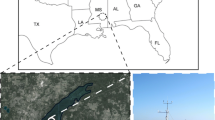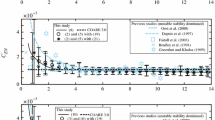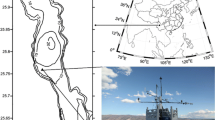Abstract
The air–water exchange of momentum and scalars (temperature and water vapour) is investigated using the Lake-Atmosphere Turbulent EXchange (LATEX) dataset. The wind waves and swell are found to affect the coupling between the water surface and the air differently. The surface-stress vector aligns with the wind velocity in the presence of wind waves, but a wide range of stress–wind misalignment angles is observed during swell. The momentum transport efficiency decreases when significant stress–wind misalignment is present, suggesting a strong influence of surface wave properties on surface drag. Based on this improved understanding of the role of wave–wind misalignment, a new relative wind speed for surface-layer similarity formulations is proposed and tested using the data. The new expression yields a value of the von Kármán constant (\(\kappa \)) of 0.38, compared to 0.36 when using the absolute wind speed, as well as reduced data fitting errors. Finally, the ratios of aerodynamic to scalar roughness lengths are computed and various existing models in the literature are tested using least-square fitting to the observed ratios. The tests are able to discriminate between the performance of various models; however, they also indicate that more investigations are required to understand the physics of scalar exchanges over waves.












Similar content being viewed by others
References
Andreas EL, Claffey KJ, Jordan RE, Fairall CW (2006) Evaluations of the von Kármán constant in the atmospheric surface layer. J Fluid Mech 559:117–149
Ataktürk SS, Katsaros KB (1999) Wind stress and surface waves observed on Lake Washington. J Phys Oceanogr 29:633–650
Belcher SE, Hunt JCR (1993) Turbulent shear flow over slowly moving waves. J Fluid Mech 251:109–148
Belcher SE, Hunt JCR (1998) Turbulent flow over hills and waves. Annu Rev Fluid Mech 30:507–538
Bernardes M, Dias NL (2010) The alignment of the mean wind and stress vectors in the unstable surface layer. Boundary-Layer Meteorol 134:41–59
Bintanja R, Van Den Broeke MR (1995) Momentum and scalar transfer coefficients over aerodynamically smooth antarctic surfaces. Boundary-Layer Meteorol 74:89–111
Bou-Zeid E, Meneveau C, Parlange MB (2004) Largeeddy simulation of neutral atmospheric boundary layer flow over heterogeneous surfaces: blending height and effective surface roughness. Water Resour Res 40:W02505
Brutsaert W (1975a) A theory for local evaporation (or heat transfer) from rough and smooth surfaces at ground level. Water Resour Res 11:543–550
Brutsaert W (1975b) The roughness length for water vapor sensible heat, and other scalars. J Atmos Sci 32:2028–2031
Brutsaert W (1992) Stability correction functions for the mean wind speed and temperature in the unstable surface layer. Geophys Res L 19:469–472
Brutsaert W (1998) Land-surface water vapor and sensible heat flux: spatial variability, homogeneity, and measurement scales. Water Resour Res 34:2433–2442
Brutsaert W (2005) Introduction to hydrology. Cambridge University Press, Cambridge
Brutsaert W, Toba Y (1986) A quasi-similarity between wind waves and solid surfaces in their roughness characteristics. J Oceanogr Soc Jpn 42:166–173
Charnock H (1955) Wind stress on a water surface. Q J R Meteorol Soc 81:639–640
Donelan MA, Drennan WM (1997) The air–sea momentum flux in conditions of wind sea and swell. J Phys Oceanogr 27(10):2087–2099
Donelan MA, Dobson FW, Smith SD, Anderson RJ (1993) On the dependence of sea surface roughness on wave development. J Phys Oceanogr 23(9):2143–2149
Drennan WM, Kahma KK, Donelan MA (1999) On momentum flux and velocity spectra over waves. Boundary-Layer Meteorol 92:489–515
Drennan WM, Graber HC, Hauser D, Quentin C (2003) On the wave age dependence of wind stress over pure wind seas. J Geophys Res Oceans 108:8062
Garratt JR, Hicks BB (1973) Momentum, heat and water vapour transfer to and from natural and artificial surfaces. Q J R Meteorol Soc 99:680–687
Geernaert GL, Hansen F, Courtney M, Herbers T (1993) Directional attributes of the ocean surface wind stress vector. J Geophys Res Oceans 98:16571–16582
Grachev AA, Fairall CW (2001) Upward momentum transfer in the marine boundary layer. J Phys Oceanogr 31:1698–1711
Grachev AA, Fairall CW, Hare JE (2003) Wind stress vector over ocean waves. J Phys Oceanogr 33:2408–2429
Hanley KE, Belcher SE, Sullivan PP (2010) A global climatology of wind-wave interaction. J Phys Oceanogr 40(6):1263–1282
Hara T, Belcher SE (2002) Wind forcing in the equilibrium range of wind-wave spectra. J Fluid Mech 470:223–245
Higgins C, Froidevaux M, Simeonov V, Vercauteren N, Barry C, Parlange MB (2012) The effect of scale on the applicability of Taylor’s hypothesis in the atmospheric boundary layer. Boundary-Layer Meteorol 143(2):379–391
Högström U, Smedman AS, Sahleé E, Drennan WM, Kahma KK, Pettersson H, Zhang F (2009) The atmospheric boundary layer during swell: a field study and interpretation of the turbulent kinetic energy budget for high wave ages. J Atmos Sci 66(9):2764–2779
Högström U, Smedman AS, Semedo A, Rutgersson A (2011) Comments on “A global climatology of wind-wave interaction”. J Phys Oceanogr 41:1811–1813
Högström U, Rutgersson A, Sahlée E, Smedman AS, Hristov TS, Drennan WM, Kahma KK (2013) Air–sea interaction features in the Baltic Sea and at a Pacific trade-wind site: an inter-comparison study. Boundary-Layer Meteorol 147:139–163
Högström U, Sahlée E, Smedman AS, Rutgersson A, Nilsson E, Kahma KK, Drennan WM (2015) Surface stress over the ocean in swell-dominated conditions during moderate winds. J Atmos Sci 72:4777–4795
Holthuijsen LH (2010) Waves in oceanic and coastal waters. Cambridge University Press, Cambridge, p 404
Janssen P (2004) The interaction of ocean waves and wind. Cambridge University Press, Cambridge, p 312
Kader AB, Yaglom AM (1990) Mean fields and fluctuation moments in unstably stratified turbulent boundary layers. J Fluid Mech 212:637–662
Kitaigorodskii SA, Volkov YA (1965) On the roughness parameter of the sea surface and the calculation of momentum flux in the near-water layer of the atmosphere. Izv Atmos Ocean Phys 1:973–988
Kudryavtsev VN, Makin VK (2001) The impact of air-flow separation on the drag of the sea surface. Boundary-Layer Meteorol 98:155–171
Kudryavtsev VN, Makin VK (2004) Impact of swell on the marine atmospheric boundary layer. J Phys Oceanogr 34:934–949
Li D, Bou-Zeid E (2011) Coherent structures and the dissimilarity of turbulent transport of momentum and scalars in the unstable atmospheric surface layer. Boundary-Layer Meteorol 140:243–262
Lighthill J (2001) Waves in fluids. Cambridge University Press, Cambridge
Lumley J, Panofsky H (1964) The structure of atmospheric turbulence. Interscience, New York
Mahrt L, Vickers D, Sun J, Jensen NO, Jorgensen H, Pardyjak E, Fernando H (2001) Determination of the surface drag coefficient. Boundary-Layer Meteorol 99:249–276
Makin VK (2003) A note on a parameterization of the sea drag. Boundary-Layer Meteorol 106:593–600
Nordeng TE (1991) On the wave age dependent drag coefficient and roughness length at sea. J Res 96:7167–7174
Owen PR, Thomson WR (1963) Heat transfer across rough surfaces. J Fluid Mech 15:321
Pan J, Wang DW, Hwang PA (2005) A study of wave effects on wind stress over the ocean in a fetch-limited case. J Geophys Res Oceans 110:93–106
Phillips OM (1977) The dynamics of the upper ocean. Cambridge University Press, Cambridge
Pierson WJ, Moskowitz L (1964) A proposed spectral form for fully developed wind seas based on the similarity theory of S. A. Kitaigorodskii. J Geophys Res Oceans 69:5181–5190
Rieder KF (1997) Analysis of sea-surface drag parameterizations in open ocean conditions. Boundary-Layer Meteorol 82:355–377
Rieder KF, Smith JA (1998) Removing wave effects from the wind stress vector. J Geophys Res 103:1363–1374
Rieder KF, Smith JA, Weller RA (1994) Observed directional characteristics of the wind, wind stress, and surface waves on the open ocean. J Geophys Res 99:22–589
Rutgersson A, Smedman AS (2001) Use of conventional stability parameters during swell. J Geophys Oceans 106:27–117
Sheriff N, Gumley P (1966) Heat-transfer and friction properties of surfaces with discrete roughnesses. Int J Heat Mass Transf 9:1297–1300
Salesky ST, Chamecki M, Dias NL (2012) Estimating the random error in eddy-covariance based fluxes and other turbulence statistics: the filtering method. Boundary-Layer Meteorol 144:113–135
Smedman AS, Högström U, Bergström H, Rutgersson A, Kahma KK, Pettersson H (1999) A case study of air–sea interaction during swell conditions. J Geophys Res Oceans 104:25833–25851
Smedman AS, Högström U, Sahleé E, Drennan WM, Kahma KK, Pettersson H, Zhang F (2009) Observational study of marine atmospheric boundary layer characteristics during swell. J Atmos Sci 66:2747–2763
Stull RB (1988) An introduction to boundary layer meteorology. Springer, Dordrecht
Sullivan PP, McWilliams JC (2010) Dynamics of winds and currents coupled to surface waves. Annu Rev Fluid Mech 42:19–42
Sullivan PP, Edson JB, Hristov T (2008) Large-eddy simulations and observations of atmospheric marine boundary layers above nonequilibrium surface waves. J Atmos Sci 65:1225–1245
Vercauteren N, Bou-Zeid E, Parlange MB, Lemmin U, Huwald H, Selker J, Meneveau C (2008) Subgrid-scale dynamics of water vapour, heat, and momentum over a lake. Boundary-Layer Meteorol 128:205–228
Vercauteren N, Bou-Zeid E, Huwald H (2009) Estimation of wet surface evaporation from sensible heat flux measurements. Water Resour Res 45:735–742
Webb EK, Pearman GI, Leuning R (1980) Correction of flux measurements for density effects due to heat and water vapour transfer. Q J R Meteorol Soc 106:85–100
Weber RO (1999) Remarks on the definition and estimation of friction velocity. Boundary-Layer Meteorol 93:197–209
Wyngaard JC, Cot OR, Izumi Y (1971) Local free convection, similarity, and the budgets of shear stress and heat flux. J Atmos Sci 28:1171–1182
Yang D, Meneveau C, Shen L (2013) Dynamic modelling of sea-surface roughness for large-eddy simulation of wind over ocean wavefield. J Fluid Mech 726:62–99
Zhao ZK, Liu CX, Li Q, Dai GF, Song QT, Lv WH (2015) Typhoon air–sea drag coefficient in coastal regions. J Geophys Res Oceans 120:716–727
Zilitinkevich SS, Grachev AA (2001) Notes and correspondence: scaling reasoning and field data on the sea surface roughness lengths for scalars. J Atmos Sci 58:320–325
Acknowledgements
This work is supported by the Army Research Office under contract number W911NF-15-1-0003 (program Manager Julia Barzyk) and by the US National Science Foundation’s Sustainability Research Network Cooperative Agreement 1444758. Drs. Ulrich Lemmin and Hendrik Huwald also contributed significantly to the data collection effort during the field campaign. MBP gratefully acknowledges NSERC Discovery Grant.
Author information
Authors and Affiliations
Corresponding author
Appendices
Appendix A
We use the formulation of MOST for differences between two heights above the surface (yielding 6 different measurements from the four levels of LATEX), as given by Eq. 10. The functional form of \(\varPsi \) is taken from Eq. 2.58 and Eq. 2.63 in Brutsaert (2005). Note that even if \(U_\mathrm{c}\) is taken as \(U_\mathrm{r}\), the wave phase speed ccancels out from Eq. 10 since it is also related to the ‘surface state’, which is identical for the four different heights, but the cos(\(\gamma )\) multiplier will remain.
To test whether the modified MOST for water surfaces is better than the classic formulation, we can write Eq. 9 or 10 with \(U_{c~}= \quad U\) or \(U_\mathrm{c}=U_\mathrm{r}\), and then check which form better yields (i) the correct slope which should be given by \(\kappa ^{-1}\) (ii) a better fit to the data with lower fitting residuals. To that end, a least-square error linear fitting can be applied to Eq. 10 for each 15-min period (t) independently, which we can write in a general form
where the left-hand side is either \(\Delta U_{j} =\frac{U(z_{k1})-U(z_{k2})}{u_{*}}\) or \(\Delta U_{j} =\frac{\left| {\cos (\gamma )U(z_{k1})} \right| -\left| {\cos (\gamma )U(z_{k2})} \right| }{u_{*}}\); j is 1–6 depending on which combination of two levels (\(z_{k1}\) and \(z_{k2})\) are chosen to take the differences; t is an indicator for the time period; \(\Delta Z_{j}\) is \(\left( \ln \left( {z_{k1} } \right) -\varPsi \left( {z_{k1} /L} \right) -\ln \left( {z_{k2} } \right) +\varPsi \left( {z_{k2} /L} \right) \right) \) and \(B_{1}\) is the slope to be deduced from the least-square fitting (a value is obtained for every time period) and will yield a value of \(\kappa ^{-1}\). Thus, what we are minimizing to get the optimal fit is the sum of the squared errors over the six two-level differences, for each time period independently.
To ensure the robustness of this statistical test and the validity of the constant-stress layer assumption, we impose an additional criterion commonly used for the evaluation of the von Kármán constant from atmospheric surface-layer data (Andreas et al. 2006). Specifically, we limit the data used to periods in which the median of the measured \(u_{*}(z)\), used in Eq. 10, only deviates by less than 10% from the surface value \(u_{*0}\) obtained from a linear fit of the friction velocity measurements at the four height following: \(u_{*} = az+u_{*0}\) (a is a constant obtained from least-square fitting). In addition, following the procedure in Andreas et al. (2006), we use the median of \(u_{*} (z)\) in Eq. 12 for all level combinations. The same criterion to choose runs that satisfy the random error limit as described previously is also applied. This limits the number of periods to 161. A least-square error minimization with respect to \(B_{1}\) in Eq. 12 over these 15-min periods is carried out using the two velocity scales U and \(U_\mathrm{r}\).
Appendix B
To calculate the scalar roughness lengths in Eqs. 2 and 3, air temperature and water vapour concentration are obtained from the Rotronic sensor; the friction velocity \(u_{*}\), kinematic sensible heat flux \(H/\rho C_\mathrm{p}\) and kinematic water vapour flux \(E/\rho \) are the averages over the four measurement heights. The lake surface is assumed to be saturated, and thus \(q_\mathrm{s}\) is calculated using the Clausius–Clapeyron relation based on lake surface temperature obtained from the Bowen ratio method. This approach using the Bowen ratio has already been used by Bintanja and Broeke (1995) to compute the scalar roughness lengths.
According to Vercauteren et al. (2009), the surface temperature was measured by two independent sensors, which are prone to different sources of errors. One is a thermocouple, which was kept at tens of mm below the surface; it had errors due to its (lack of) immersion or radiative heating. The other, an infrared sensor, had errors related to its sensor body temperature correction and infrared transmissivity of the lake water. There were periods of missing data for the thermocouple because of the immersion. The large discrepancy among three methods shown in Fig. 13b can be attributed to these errors. Note that for small discrepancy in surface temperature, \(z_{0h}\)is also quite consistent among the different methods as expected (See Fig. 13a). Nevertheless, the extremely high and low values in \(z_{0h}\) are likely to be unphysical. Furthermore, \(z_{0h}/z_{0v}\) in Fig. 13c shows that although we assumed equal turbulent transfer efficiency to infer the surface temperature as described in Sect. 5.1, this does not necessarily imply that \(z_{0h}/z_{0v}=1\). It is worth noting that the three methods for computing the surface temperature (thermocouple measurement, infrared sensor measurement and Bowen ratio method) give a ratio of the scalar roughness lengths that is very close to 1 when the measured temperatures agree, suggesting that these are the periods where the results are most robust. The Bowen ratio method results in \(z_{0h}/z_{0v}\) ratios that departs the least from 1, again indicating it is the preferred method.
Comparisons between different methods of obtaining surface temperature (\(\theta _{BR}\): Bowen Ratio method; \(\theta _{IR}\): infrared gun measurement; \(\theta _{TC} \): thermal couple measurement). \(z_{0s}\) is either \(z_{0h}\) or \(z_{0v}\). a \(z_{0h}\) computed from three different methods. b Lake surface temperature obtained from the three different methods. c Ratio between \(z_{0h}\) and \(z_{0v}\) obtained from the three different methods
Rights and permissions
About this article
Cite this article
Li, Q., Bou-Zeid, E., Vercauteren, N. et al. Signatures of Air–Wave Interactions Over a Large Lake. Boundary-Layer Meteorol 167, 445–468 (2018). https://doi.org/10.1007/s10546-017-0329-z
Received:
Accepted:
Published:
Issue Date:
DOI: https://doi.org/10.1007/s10546-017-0329-z





